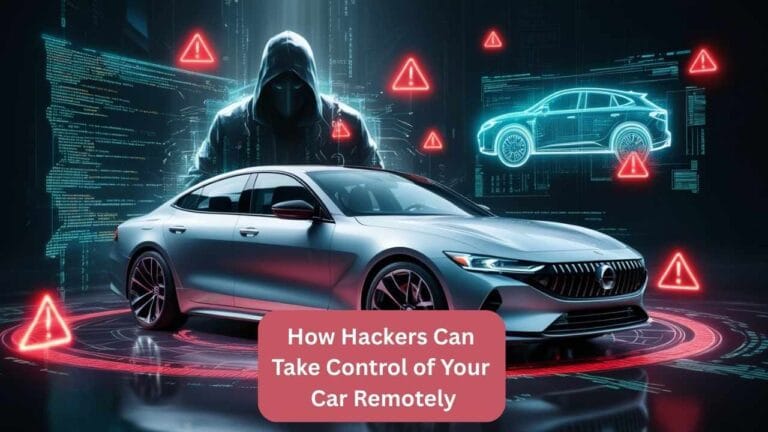Imagine driving down the highway when suddenly your steering wheel locks, your brakes fail, or your engine shuts off, all controlled by a hacker miles away. This isn’t science fiction; it’s happening today. Modern cars are essentially “computers on wheels,” and just like your laptop or smartphone, they’re vulnerable to cyberattacks.
I’ve spent years as an automotive cybersecurity specialist, and what most drivers don’t realize is that hackers don’t need physical access to your car anymore. A 2024 study by Upstream Security found that 40% of cyberattacks on vehicles are now executed remotely, exploiting wireless connections like Bluetooth, Wi-Fi, and even cellular networks. Let’s break down how this happens, and how you can protect yourself.
How Hackers Remotely Hijack Cars: The Shocking Truth
Hackers take control by exploiting vulnerabilities in your car’s connected systems, usually through apps, key fobs, or infotainment systems.
The 4 Most Common Attack Methods
- App Exploits
- Many car manufacturers offer smartphone apps to remotely start, lock, or locate your vehicle.
- Real-World Example: In 2023, researchers found a flaw in a popular EV app that allowed hackers to unlock and start cars via Bluetooth relay attacks (source: IEEE Transactions on Vehicular Technology).
- Key Fob Relay Attacks
- Hackers use $50 radio devices to amplify your key fob’s signal, tricking your car into thinking the fob is nearby.
- Case Study: A client in Miami had his luxury SUV stolen in 30 seconds this way—while his key was inside his house.
- Infotainment System Hacks
- Malware can infect your car through a compromised USB drive or malicious website accessed via the built-in browser.
- 2025 Report: Kaspersky Lab found that 1 in 5 infotainment systems have unpatched security flaws.
- Cellular Network Takeovers
- Some luxury cars use 5G for remote updates. Hackers can spoof these signals to send malicious commands.
Bold Takeaway: If your car has wireless connectivity, it’s potentially hackable.
The Hidden Risk Everyone Ignores (Even Dealerships!)
Your car’s software is often years out of date, and manufacturers don’t always notify you.
- A 2024 Consumer Reports investigation found that 60% of drivers never update their car’s software, leaving known vulnerabilities unpatched.
- Why? Unlike phones, most cars don’t auto-update. You might be driving with a 2019-era security system in 2025.
Actionable Fix:
Check for updates monthly via your manufacturer’s website or dealership.
Enable “Over-the-Air” updates if your car supports them (Tesla, BMW, and Ford now do).
Myth Debunked: “Only Luxury Cars Are at Risk”
Reality: Even budget cars with Bluetooth or app connectivity are vulnerable.
- 2023 Attack: Hackers exploited a vulnerability in a popular budget sedan’s telematics system to disable engines remotely (reported by Wired).
- Expert Quote:
“It’s not about the car’s price—it’s about whether it’s connected to the internet.”
(Dr. Andrea Amico, Founder of Privacy4Cars)
Visual Analogy:
Think of your car’s security like your home’s Wi-Fi. Even a cheap router can be hacked if it’s not protected.
How to Secure Your Car in 15 Minutes (Step-by-Step)
Step 1: Disable Wireless Entry (When Possible)
- Prep: Use the physical key instead of wireless key fobs at home.
- Modify: Store fobs in a Faraday pouch ($10 on Amazon) to block signal hijacking.
Step 2: Update Your Car’s Software
- Progress: Google “[Your Car Brand] + software update” to find the latest patches.
Step 3: Secure Connected Apps
- Enable two-factor authentication (2FA) on any car apps.
- Revoke app access if you sell the car.
Step 4: Monitor for Strange Behavior
- Warning signs:
- Unusual battery drain (malware running in background)
- Settings changing randomly
Pro Tip: Some insurers now offer “cyber rider” policies for hacked vehicles, ask yours!
Final Thoughts: Don’t Panic, Prepare
While the risks are real, a few simple steps drastically reduce your vulnerability.
As vehicles become more connected, the risk of remote hacking increases. Understanding the methods hackers use to exploit vulnerabilities is the first step in protecting yourself. By staying informed, keeping your vehicle’s software updated, and practicing good cybersecurity hygiene, you can reduce the risk of falling victim to a remote car hack.
Remember, cybersecurity is an ongoing process. Regularly review your vehicle’s security features and stay updated on the latest threats to ensure you remain one step ahead of potential attackers.
Your Turn: Have you ever experienced a suspicious car hack attempt? Share your story below, let’s keep the conversation (and protection) going!





